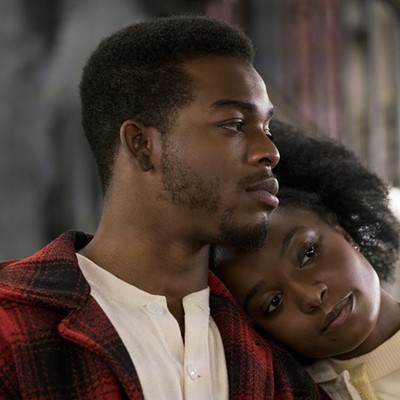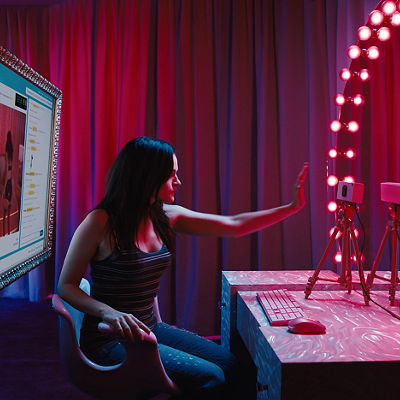It happened in Kansas City almost 25 years ago, when Warner Bros. previewed Sam Peckinpah's The Wild Bunch. As the opening scene unfolded, the audience knew they weren't watching any ordinary Western. A group of grizzled bandits (William Holden, Ernest Borgnine, Warren Oates and Ben Johnson) try to rob a bank in a Texas border town, get ambushed by lawmen and have to shoot their way out. The scene mixed slow and fast motion, long shots and close-ups in a delirious dance of death, with bodies pinwheeling through space, crashing through windows, jerking spasmodically as rounds riddled them, gushing small fountains of blood and guts.
From that moment forward, the film wallowed in a kinetic, hyperreal, terrifying portrayal of violence such as had never been seen before. Biographer David Weddle describes the screening vividly in his 1994 book about Peckinpah, If They Move ... Kill 'em!. "Thirty people bolted up the aisle and out of the theater, some to vomit in the adjoining alley. But most remained pinned to their seats, horrified yet transfixed .... 'I want to get the hell out of this place!' someone cried a few rows away. Another woman screamed, sprang from her seat and ran out of the theater."
But most people stayed. "Peckinpah viewed the anger of those who sat through the entire movie with irony," Weddle wrote. "He suspected the real target of their rage was not him, but themselves. 'They want to walk out, but they can't,' he would say later. 'They can't turn their faces away, and that makes them mad.'"
That single introspective comment summarizes just what makes the films of Sam Peckinpah, who died in 1984, so enduringly fascinating.
Peckinpah's chief claim to fame was his portrayal of movie violence; it was also his claim to infamy. In the months following the premiere of The Wild Bunch -- which has now been re-released in a director's cut that adds a few crucial minutes to the film seen originally in 1969 -- small forests were mowed down to accommodate all the essays penned by critics who couldn't stop talking about the movie.
The lion's share of discussion centered on the director's penchant for slow-motion bloodbaths. At the time, Peckinpah defended his technique as a deglamorization of violence, a detailed representation of its physical consequences that was meant to repel people, to shock them, to make them hate violence and never want to have anything to do with it. But nobody was fooled: critics and audiences alike speculated that no man who truly loathed violence could possibly portray it as beautifully as Peckinpah.
They were both right and wrong. Peckinpah was a complex man and an artist of enormous contradictions -- a cynic with a mile-wide streak of romanticism; a man with deep-rooted pacifist tendencies who also loved drunken brawls; a one-time Marine who witnessed real-life killings galore, yet never stopped loving violent genre movies; and a sensitive fan of poetry and music who nurtured a lifelong fascination with caveman codes of honor.
Peckinpah cut his creative teeth writing TV shows during the eras of Ike and JFK, creating The Virginian and The Rifleman, two series about the conflict between civilization and savagery. Then he jumped to movies, where he developed his unique method of choreographing violence. Although he built scenes of considerable brutality into his first two pictures, 1962's Ride the High Country and 1964's Major Dundee, he didn't flower into a bona fide poet of gore until he made The Wild Bunch.
A quarter of a century ago, certain film critics noted that if The Wild Bunch was Peckinpah's clearest and purest statement as an artist, then his attitude toward movie violence had to be deeply conflicted. They were right: on one hand, he was clearly wrapped up in the thrill of it all, getting a Neanderthal contact high from the sight of corpses sailing through space and bullets tearing golf ball-sized holes in human flesh. On the other hand, The Wild Bunch offered no hint that Peckinpah viewed the consequences of violence with anything but complete seriousness.
He treated human bodies as puppets to be jerked around during close-quarters gunfights, yet the people doing the shooting were not carefree or happy. They were sad, lonely men pushed into bloodshed by their own rigid codes of loyalty, honor and determination. They were Westerners doing what a man's gotta do -- but in Peckinpah's weathered hands, that phrase took on a ghastly, existential, tragic hue. They were doing what a man had to do because modern society left them one rotten choice: either blast your way toward total, unrestricted, amoral freedom, or live a quiet life of civilized desperation.
It's this philosophical underpinning -- no matter how retrograde and repulsive it might seem to some -- that makes Peckinpah an artist of continuing importance. He's aware of the gaping pits in his own creative reasoning, the looming shadows of fascist demagoguery set up by his characters and situations. Like Charles Manson, Oliver North and other aggressive, self-mythologizing loners, Peckinpah's Wild Bunch carve out their own personal moral niche and tell the rest of the world to go to hell. They think nothing of wasting civilians to escape a besieged town, but when one of their own is murdered, they come out blasting and don't let up until every last score has been settled.
On some level, even the least sophisticated moviegoers realize that what they see when they watch a violent movie is representation, not reality. How they respond depends on how much violence they've experienced in real life, their religious and philosophical beliefs and a number of other personal factors. Yet ultimately, each time a viewer draws a line and says, "I will accept exactly this much bloodshed in entertainment and no more," it's for the same reason: because the film in question has not established a clear artistic context for the violence it portrays. When a film establishes a moral and artistic framework for its violence, it can take you anywhere and show you anything. You may not like what you see, but you can appreciate that there's genuine thought behind it.
Though countless filmmakers have lifted Peckinpah's violent visuals, they've often done so without thinking very hard about where those images came from, about the demons that drove a lonely, alcoholic, pill-popping, womanizing, manic-depressive ex-Marine to come up with a new way of looking at violence, arguing about it and dreaming about it.
In the Rambo films, for instance, Peckinpah-style violence is trotted out like a fashion accessory; there's nothing in them to indicate an ambivalence about violence, or even that their scenes of graphic bloodshed are intended to provoke any thought at all. In The Terminator, at least one serious aspect of Peckinpah's violence is being evoked -- the part that reminds us of the fragility of human bodies, and how helpless they are in the face of deadly technology. But because the film is a comic-book thrill ride, its violence is ultimately more a matter of style than world-view.
Other times, the invocation of Peckinpah is a bit more thought provoking. In Hard Boiled, John Woo infuses comic book characters and situations with an operatic level of emotion, and when he borrows from Peckinpah, he puts his own stamp on everything he takes. The bloody violence is torqued up to insanely high levels because the filmmaker wants to give us a wild, orgasmic release -- an epic catharsis that can do justice to his brooding heroes and villains. In Reservoir Dogs, the much-discussed cop torture sequence gives us a voyeuristic thrill, yet at the same time it makes us deeply uncomfortable. It makes us feel both giddy and repulsed.
But here's the caveat: as occasionally brilliant as Peckinpah borrowers such as Woo and Quentin Tarantino can be, there's nothing truly dangerous about their movies, nothing that forces you to look within yourself after the final credit has faded and question who you are, what you believe and whether you, too, would be willing to kill to defend a lifestyle, a friend or an idea. With someone such as Tarantino, sincerity and passion simply aren't part of the picture. It's revealing to note that his movies, especially Pulp Fiction, are most often discussed not in terms of emotion and meaning, but "outrageousness" and "audacity" -- as if the notion of treating pain and death as a sight gag was no more or less disturbing than dying your hair orange or eating pizza for breakfast. There's something secondhand and safe about the violence in Pulp Fiction. As gory and nasty as it is, it feels abstracted, even playful.
This quality is what makes Tarantino such a poor subject for debates about movie violence. Arguing the possible effects of the mayhem showcased in Pulp Fiction -- or the latest Steven Seagal movie, for that matter -- is like debating the effects of the dance numbers in Oklahoma!. What you're debating is the ratio of an ingredient in a film recipe, struggling to decide whether the artist used too much spice or not enough.
But other kinds of movie violence spring from a primal artistic impulse that can't be laughed at or shaken off. This kind of violence -- Peckinpah's kind of violence -- comes from the friction created by an artistic mind struggling to resolve profound contradictions. The demons wrestling inside a filmmaker create sparks that rise up, catch fire and consume the boundaries of the screen. The violence of The Wild Bunch comes from the national agonies of World War II and Korea and Vietnam, and from sudden, shocking eruptions of domestic savagery, on city streets and inside darkened bedrooms. That violence is still with us today. It's everywhere. It's hanging in the muggy night air as bored, armed teenagers from impoverished households struggle to find a way to feel like men. It's clinging to the portals of helicopter gunships and aircraft carriers and the handgrips of U.N. rifles and police-issue billy clubs. It's like a poisonous fungus forever in need of sustenance, forever moving and reproducing, finding new host bodies in new generations of human life.
In The Wild Bunch, Sam Peckinpah captures the deep-rooted human need to lash out savagely, projects it out over our heads in color, in stereo, and lets it hang there and wriggle in space.
The filmmaker's alter ego, Pike Bishop, the homicidal antihero of The Wild Bunch played by William Holden, carries himself like a man who's been staring at that wriggling vision his whole life. But he keeps moving, thinking and acting, delighting us and appalling us. We're never asked to look at him with either sympathy or scorn, just to look at him, to feel what he feels and to consider the fate of the society that produced him.
That's all Sam Peckinpah ever wanted: he wanted us to look, and then to ask why we look. The difference between Quentin Tarantino and Sam Peckinpah is the difference between a writer and a dreamer, between ink and blood, between cheekiness and guts. It's the difference between pulp and flesh.
The Wild Bunch.
Directed by Sam Peckinpah. With William Holden, Ernest Borgnine, Warren Oates and Ben Johnson.
Rated R.
144 minutes.





